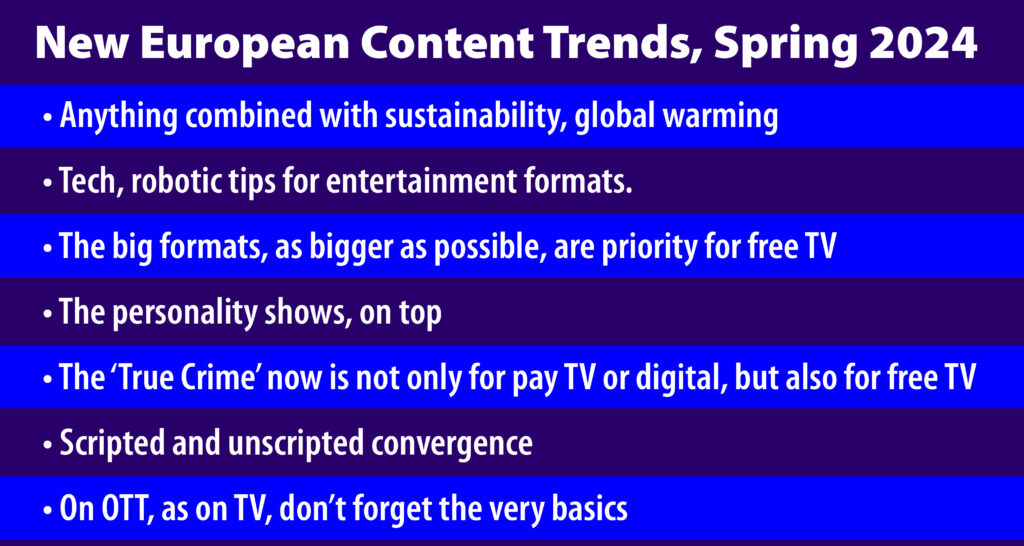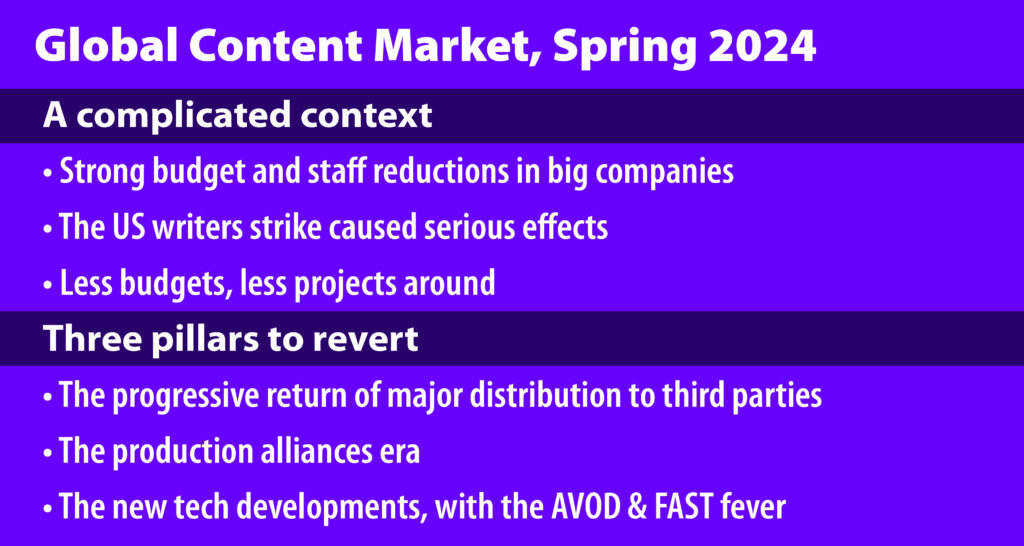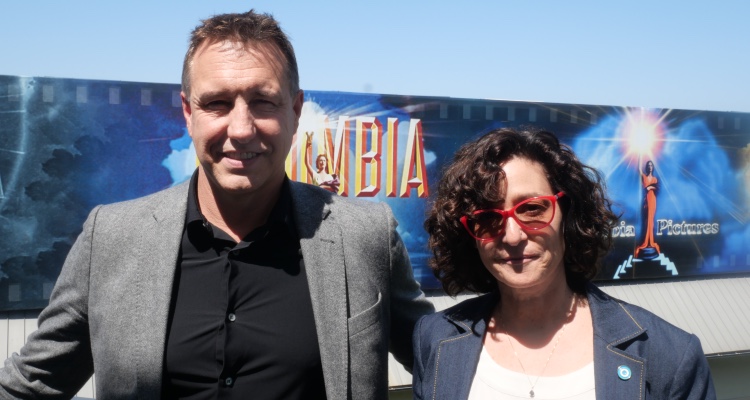
The spring content markets have been held in France: Series Mania took place March 19-21 in Lille, with its Festival around, while MIPTV is developed in Cannes through April 8-10, with MIPdoc and MIPformats the previous weekend. The first one is growing as a series-focused convention, good to get in touch with European players that are not at the MIPs. The second, focused mainly on docs, facts and formats, develops this year its last edition, after the very recent RX France announcement of launching MIPLondon in late February, instead —see article apart. What must be taken in mind this fall? The big companies are suffering strong budget and staff reductions worldwide, due to the global stop of SVOD projects and the last year’s U.S. writer strike. Everything has got harder. To be successful is possible, but you must be fresh and particularly smart.
There are three pillars in the content arena that stop the bad mood and push fresh business: the progressive return of major distribution to third parties, which reinforces the events and the fragmentation in general; the production alliances, that promote more and more coproduction models, production hubs, etc. to keep original production levels; and the new tech developments, with the AVOD & FAST fever as a main answer to SVOD problems to keep incomes growing and to make content, in general, more productive.
These trends appeared in the market some years ago, but they continue getting stronger and even they seem to be just at starting levels, with much more each to come. Today there are no fiction project without many coproduction partners, and every broadcaster is planning to launch an AVOD platform and/or FAST channels for this year or so if they are not already releasing.
Why so complicated?Latam answers
It is difficult to accept in an expanding business, but it is logical at the same time. After the pandemic, all businesses became more compact and conservative than in the past. The content industry lived a party with the big SVODs launches and the unusual boom of original productions for them everywhere. At that moment, the trend seemed like the .com bubble… progressive growth was not enough to justify so many productions, the production costs got higher and higher… the global reduction finally came for the OTTs and the industry —-the big US and European studios, the big format providers, etc.— must adapt itself.
However, the problem has been the bubble, not the real demand, that continues growing and need more than ever smart solutions. So, players like Caracol and RCN in Colombia, for instance, are producing more original series than ever for the OTTs, because they are smart in producing top content per lower costs. They know where to reduce that has no final product effects, and where’s not.

So, the main problem takes place in the central markets, where big structures and big costs are together. The crack is global because they rule the market for all regions, but as many companies are already doing, to find new options and twists overseas, it is a good path to be better and to catch emerging opportunities.
Asia, Middle East, Australia
Justly, on the three pillars mentioned above, Asia and APAC in particular, are leading regions. At Mipcom, one of the main conclusions was that Asia was back, after the long break of the pandemic. China was the top attending country at the convention, while Japan and Korea were strong engines, as soon as India, Hong Kong, Taiwan, Malaysia, Singapore, Thailand, and Indonesia, were other good sources of fresh business.
Middle East, on the other hand, was the region with top buyer growth, including cross-regional productions in the Arabic language as a current big trend. And we must talk especially about Australia. Today is one of the top players in co-production ventures with the US big studios and European titans, as in the past was just Japan. Last year, from ten new series presented by the US major studios in LA Screenings, 3-4 had Australian partners, apart from the UK or German ones. Awesome.
The US market gets more international
US major distribution opening latest news? Disney added in some regions during January, the saleto third party of a dozen of new hit titles, from classic ‘Beaty and the Best’ to recent ‘Cruella’, ‘Mulan’ and ‘Zootopia’. WBD is operating now with three commercial levels: the exclusive product for Max —the original series and the top theatrical releases— the co-exclusive content with just one partner —recent hits— and the rest with already multiple windows.
MGM Amazon has not added new titles from October to the 48 Amazon originals opened to others but has improved sales very much. Their sales trends? The original series are demanded mainly by other VOD platforms, while the feature films are requested by free TV channels. The main product now of the merged studio is ‘Hotel Cocaine’, an MGM original series set on the 70s Miami drug dealers times.
The US market itself? Roy Ashton, from the US agency Gersh, describes the hard current picture: ‘This is a very difficult moment for big content developers, because last year’s strike stopped products that instead of launching last May, could be released during the mid-season, but this is not a good time to launch for the networks. So, you can’t sell new content if the previous wave is still to come. Thewinners of this situation have been the SVODs, because they saved production costs but continued billing. Just Netflix made cash of USD 1.5 billion due to this. What can do the agencies as ours? To push international TV business, but there are lower budgets, or to go into other segments, as sports or social media’.
New trends in the main European markets?
Javier Pérez Da Silva, from Beta Spain, resumes the newest trends that make the situation better for players that follow them. First, he stresses this is a comparative good moment for European broadcasters, that due to OTT stops, take more attention and more projects from the industry. ‘They are more reliable’, it is said.

Newest trends:‘• Anythingcombinedwithsustainability, and global warming, work. Anything, even bizarre mixes. • All the tech, robotic tips, are in demand for entertainment formats. • The big formats, as bigger as possible, are a priority for free TV prime times. • The personality shows: realities, home & health, anything with famous people: singers, millionaires, etc. Music personality shows are on top’.
‘• The ‘True Crime’ now is not only for pay TV or digital, but also for free TV, getting unique rating numbers. • Scripted and unscripted converge… entertainment shows look for fiction-hits: emotions, conflicts, and iconic characters. • Beyond the new media, it is important not to forget the basics: ‘You have to program your channel for the people that look at your channel. If a reality is targeted 16-20, won’t work in any free TV or VOD, if they are mainly for -14 or +40 people… ‘.
Ups & downs wrap-up
As it can be seen easily, the new trends are a combination of basics with fresh or twisted tips. Business stands and evolves, and gets pendular at the same time. But we can stress some ‘overall’ trends that are more than momentaneous waves, they are basements to build above for sure.
For instance, broadcasters continue betting on big-big classic formats —Factor X, etc.— to hold the prime-time family audience with them. This is for long, won’t change for years. Global new strong issues, such as technology or global warming, must be included as much as possible on any screen. The ‘True crime’ wave is not just another trend when it takes all the media models and continues growing.
Then, we have convergence: trends from fiction that go to entertainment, trends from Pay TV and digital that go to free TV, and vice-versa. These are quite obvious in the current times where production is for cross-media. The need of iconic characters, emotions, conflicts, and new sides of celebrities, will be seen at most of the content to be successful in the years to come.
How to be fresh, how to be smart, so? Perhaps, to follow some basics and to change others, assuring an authentic, surpassing final result. Easy to say, hard to concrete…for sure, a good way is to vary the staff, and the partners, to look for them in other regions, as we’ve developed above. New people, new ideas; new places, new conditions. Nowadays, the most complicated players are the ‘just traditional’ ones.
Nicolás Smirnoff







